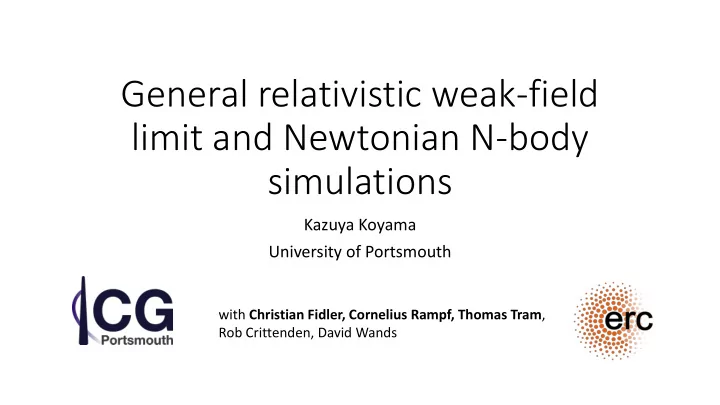

General relativistic weak-field limit and Newtonian N-body simulations Kazuya Koyama University of Portsmouth with Christian Fidler, Cornelius Rampf, Thomas Tram , Rob Crittenden, David Wands
Motivation • Future surveys (DESI, LSST, Euclid, SKA …) These surveys will go wider and deeper, probing near horizon perturbations • N-body simulations These surveys require large volume simulations cf. Euclid flagship simulation L=3.8 Gpc, N=12600 3 mock galaxies up to z=2.3 • Limitations of Newtonian simulations Newtonian dynamics is based on “ action-at-a-distance ” in absolute space and time
Questions • Are Newtonian N-body simulations consistent with weak-field limit of GR? • If so, how do we interpret Newtonian simulations in a relativistic framework? • How do we include relativistic effects missing in simulations (e.g. radiation perturbations)
Newtonian simulations • Initial conditions • N-body simulations linearisation
N-body gauge (linear perturbations) Fidler et.al. arXiv:1505.04756 • N-body gauge (anisotropic stress) Cold Dark Matter (CDM) + C.C. • Relativistic density Traceless part of 3-metric does not distort volume
Radiation perturbations Fidler et.al. arXiv:1606.05588, arXiv:1702.03221 • Radiation perturbations
Newtonian motion gauge Fidler et.al. arXiv:1606.05588, arXiv:1702.03221 • Newtonian motion gauge space threading
Newtonian motion gauge spacetime Fidler et.al. arXiv:1606.05588, arXiv:1702.03221 • Time slicing (not a unique choice)
Newtonian motion gauge metric Fidler et.al. arXiv:1606.05588, arXiv:1702.03221 with no radiation
Application to N-body simulations Fidler et.al. arXiv:1606.05588, arXiv:1702.03221 • Gauge transformation to N-body gauge At late times, radiation becomes negligible and N-body simulations are easier to interpret in N-body gauge this gauge transformation can be computed by linear Boltzmann code (CLASS)
Comparison with relativistic simulations Adamek et.al. arXiv:1703.08585 • gevolution Adamek et.al. arXiv:1604.06065 Relativistic simulation code with weak field approximation
Weak field expansion Fidler et.al. arXiv:1708.07769 • Non-linear density and velocity In Newtonian simulations, density and velocity become non-linear but the Newtonian potential remains small • Weak field expansion • Super/near horizon scales • Under horizon and linear scales (standard cosmological pert.) • Under horizon and “non - linear” scales
Weak field expansion Fidler et.al. arXiv:1708.07769 • Metric perturbations • Matter perturbations
Weak field Newtonian motion gauge Fidler et.al. arXiv:1708.07769 • Temporal gauge violates our assumption we adopt • Newtonian variables • Newtonian motion gauge This spatial gauge condition realises Newtonian (non-linear) Euler equation
Linear Boltzmann + Newtonian N-body Fidler et.al. arXiv:1708.07769 • Gauge conditions These are equations so can be computed using a linear Boltzmann code Other variables can be computed using simulation quantities
Linear Boltzmann + Newtonian N-body Fidler et.al. arXiv:1708.07769 • Relativistic corrections (radiation) + non-linear corrections Relativistic correction
Poisson gauge Fidler et.al. arXiv:1708.07769 • Relation to Poisson gauge (time slicing is the same) (space threading is different) • At late time (C.C. + CDM)
Ray tracing Fidler et.al. arXiv:1708.07769 • N-body results should be interpreted in Nm gauge photon displacement Integrated Coordinate Shift see also Adamek arXiv:1707.06938 • Chisari & Zaldarriaga description Chisari & Zaldarriaga arXiv:1101.3555
Going beyond linear order • Bispectrum including relativistic corrections • To compute quantities like bispectrum, we need a scheme to combine second order relativistic perturbations + Newtonian N-body simulations k e.g. squeezed limit B k ( , k , k ) 0 k 1 2 3 1 k 1 2 long-wavelength • 2 nd order Boltzmann code is required short-wavelength k 3 • Initial conditions • In GR, the constraint equation becomes non-linear at second order • Scalar-vector-tensor mixing • At second order, scalar, vector and tensor mix.
Second order Poisson density • Second order density in Poisson gauge full solutions with CDM + C.C. is known Villa & Rampf arXiv:1505.04782 EdS limit Newtonian solutions The dominant term in the squeezed limit
Full solutions from 2 nd order Boltzmann code Tram et.al. arXiv:1602.05933 • Comparison with SONG* Pettinari et.al. arXiv:1302.0832; arXiv:1406.2981 Fidler et.al. arXiv:1401.3296 * https://github.com/coccoinomane/song
Squeezed limit from separate universe Tram et.al. arXiv:1602.05933 • Squeezed limit • The effect of long-modes can be considered as coordinate transformations for short modes
Initial conditions • Comoving synchronous gauge Constraint equation Bruni et.al. arXiv:1307.1478; arXiv: 1405.7006 Primordial non-Gaussianity Bartolo et.al. astro-ph/0501614 There is a subtle but important difference between GR non-linearity and primordial NG Bartolo , … Sasaki,… et.al. arXiv:1506.00915
Matter evolution equations • Continuity and Euler equation Up to second order, there exists a gauge in which relativistic corrections appear only at third order Hwang and Noh astro-ph/9812007, gr-qc/0412128, 0412129 • Solutions for matter perturbations Non-linearity in the Hamiltonian constraint introduces additional GR corrections Bertacca et.al. 1501.03163 Gong & Yoo 1602.06300
GR N-body Shibata 1999 Prog. Theor. Phys. 101, 251 and 1199 • Geodesic • Constraints • Evolution equations (GR) …….
Other approaches • Weak field expansion • Weak field N-body simulations gevolution: modified N-body simulations in Poisson gauge in weak gravity limit Julian Adamek, David Daverio, Ruth Durrer, Martin Kunz Phys.Rev. D88 (2013) no.10, 103527 • Full GR simulations with dust Eloisa Bentivegna, Marco Bruni. Phys.Rev.Lett. 116 (2016) no.25, 251302 John T. Giblin, James B. Mertens, Glenn D. Starkman Astrophys.J. 833 (2016) no.2, 247
Conclusions • Newtonian motion gauge We provided a framework to interpret and use Newtonian N-body simulations in terms of the weak filed limit of general relativity at leading order • inclusion of relativistic perturbations using a linear Einstein-Boltzmann code • identification of relativistic corrections to particle positions in N-body simulations • Going beyond linear order • 2 nd order Einstein-Boltzmann code is available and tested • Relativistic corrections to initial conditions need to be included • Still missing “2 nd order Newtonian motion gauge”
Recommend
More recommend